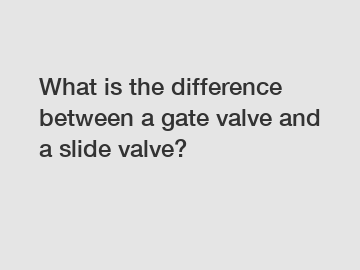What is the difference between a gate valve and a slide valve?
When it comes to controlling the flow of fluid in pipelines, valves play a crucial role. The design and functionality of these valves determine their effectiveness in regulating fluid flow. In this blog, we will delve into the differences between two prominent valve types: gate valves and slide valves. Whether you're a professional in the industry or simply curious about how these valves work, this comprehensive comparison will provide you with valuable insights.
Understanding Gate Valves:
Gate valves are popular in industrial settings due to their robust construction and ability to handle high pressure and temperature environments. These valves are designed with a wedge-shaped gate that slides in and out of the valve body to control the fluid flow. When fully open, gate valves allow virtually unrestricted flow, maximizing efficiency.

The gate valve's operational mechanism typically incorporates a handwheel or actuator that raises or lowers the gate, creating an unobstructed passage for fluid flow. By rotating the handwheel or activating the actuator, the gate rises, allowing fluid to pass through. Conversely, when the handwheel or actuator is turned the other way, the gate lowers, effectively sealing off the flow.
Key Features and Advantages of Gate Valves:
1. Quick on-off functionality: Gate valves are known for their ability to provide a complete and immediate shut-off, making them ideal for applications that require tight control over fluid flow.
2. Resilience under high-pressure conditions: The sturdy design and construction materials of gate valves allow them to withstand high-pressure environments without compromising their functionality or structural integrity.
3. Minimal pressure loss: When fully open, gate valves create a straight passageway, reducing turbulence and minimizing pressure loss.
4. Suitable for bi-directional flow: Gate valves are equally effective for controlling the flow in both directions, making them versatile for various pipeline configurations.
Understanding Slide Valves:
Slide valves, also known as knife valves, are a type of linear motion valve. Unlike gate valves, slide valves use a blade-like closure plate that moves horizontally across the fluid pathway to control flow regulation. This plate is designed to slide smoothly between two sealing surfaces, either blocking or allowing fluid flow.
The operational mechanism of slide valves involves rotating a handwheel or actuator, which moves the blade horizontally across the valve body. This progressive movement continuously alters the fluid pathway, allowing operators to adjust the flow as needed.
Key Features and Advantages of Slide Valves:
1. Precise fluid control: Slide valves provide excellent control over flow regulation, making them suitable for applications that require precise fluid handling.
2. Compact design: The linear motion of slide valves allows for a more compact overall design, enabling installation in tight spaces where gate valves may not be suitable.
3. Low maintenance: Slide valves typically have fewer parts and simpler designs, resulting in reduced maintenance requirements and costs.
4. Cost-effective solution: Due to their compact and straightforward design, slide valves are often more cost-effective than gate valves, making them a popular choice in certain applications.
Key Differences:
1. Flow control mechanism: Gate valves use a wedge-shaped gate to control fluid flow, providing an unobstructed passage when fully open. Slide valves, on the other hand, employ a horizontal blade-like closure plate to block or allow fluid flow.
2. Valve type suitability: Gate valves are commonly used in environments that require significant pressure and temperature handling, while slide valves excel in applications that necessitate fine-tuned flow control.
3. Installation flexibility: Slide valves offer greater installation versatility due to their compact design, making them ideal for space-constrained environments. Gate valves may require more significant space for installation.
4. Costs: Gate valves, with their robust construction and specialization in high-pressure settings, tend to be more expensive compared to slide valves, which are generally more affordable.
Conclusion:
Gate valves and slide valves both have distinct advantages and are suitable for specific applications. Understanding the differences between these valves is essential when selecting the most appropriate option for your pipeline systems. From quick shut-off capability and resilience under pressure to precise flow control and cost-effectiveness, gate valves and slide valves offer unique features that cater to different industry requirements. Consequently, choosing the right valve type will ensure optimal fluid regulation and enhance overall operational efficiency.
Are you interested in learning more about cast iron ball valve china, orifice air valve, Gear Worm butterfly valve? Contact us today to secure an expert consultation!

Comments
0